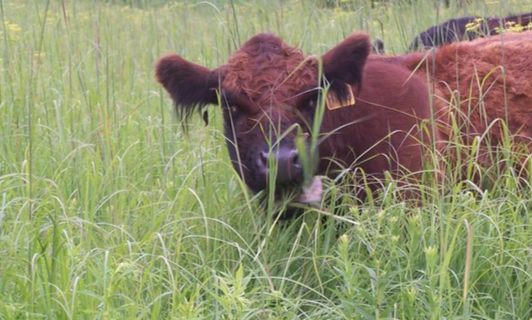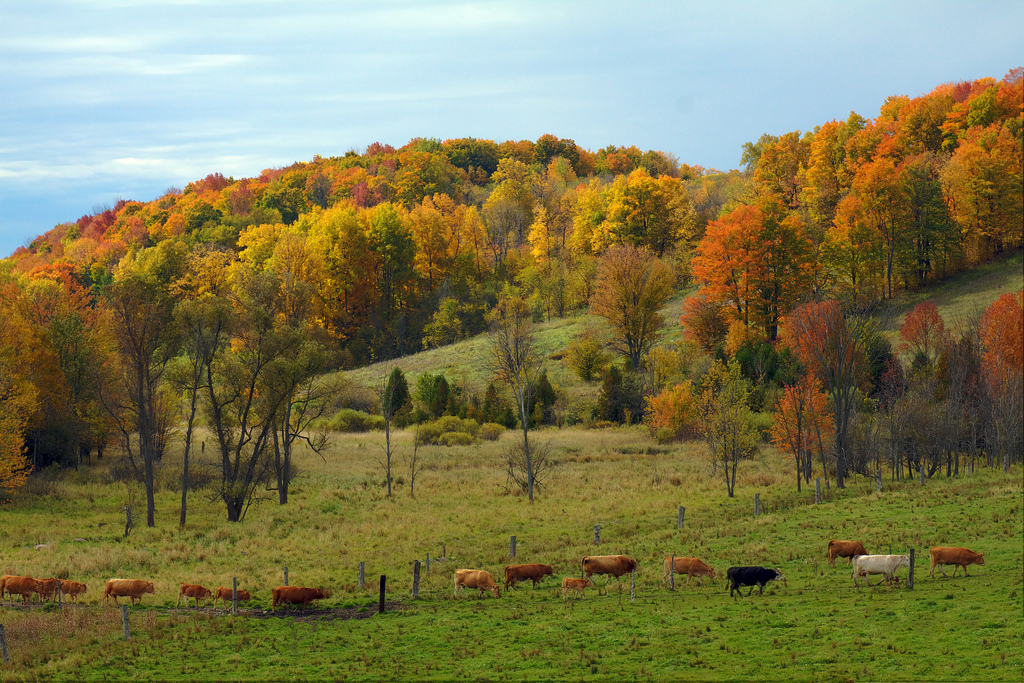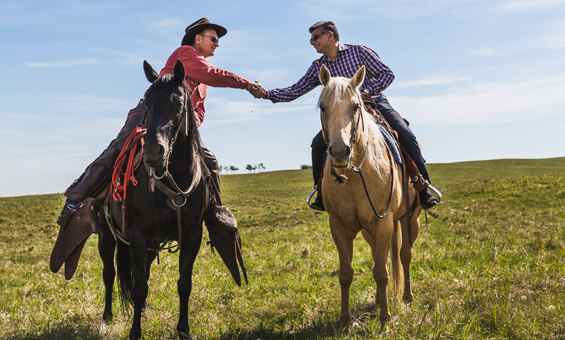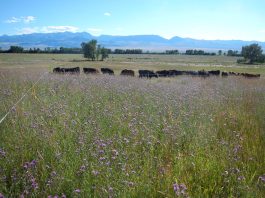Fifteen years after they’d planted a pasture of big bluestem (Andopogon gerardii), Brad and Leslea Hodgson of Root Prairie Galloways noticed that it was beginning to be overtaken by cool season grasses and weedy forbs. They had an idea that grazing the cool season plants early in the spring, before the big bluestem broke dormancy, would set the cool season plants back, and give the big bluestem the advantage it needed to begin increasing again. They tested their theory over three grazing seasons with help from grazing consultant Howard Moechnig, and a grant from North Central SARE (Sustainable Agriculture Research and Education). What they found is that they could give big bluestem the boost it needed.
 The Hodgsons subdivided the big bluestem pasture, leaving one paddock grazed so they would have a comparison for their grazing results. Cattle grazed from late April through early May starting at a stocking density of about 50,000 pounds per acre in the first year and up to 181,000 pounds per acre in year two. Paddocks measured from 50′ x 100′ to 60′ x 100′. Average time in a paddock was 10 to 12 hours, though this varied depending on forage availability.
The Hodgsons subdivided the big bluestem pasture, leaving one paddock grazed so they would have a comparison for their grazing results. Cattle grazed from late April through early May starting at a stocking density of about 50,000 pounds per acre in the first year and up to 181,000 pounds per acre in year two. Paddocks measured from 50′ x 100′ to 60′ x 100′. Average time in a paddock was 10 to 12 hours, though this varied depending on forage availability.
In the early spring these paddocks were mostly Kentucky blue grass and Canada goldenrod with some wild parsnip, asters, aspen saplings, Canada thistle, clovers, dandelion and crown vetch thrown in.
At first glance it didn’t look like the pasture had a lot of forage:

But the cows did well, mixing dry grass with green forage and didn’t seem to experience any nutritional problems. Grazing a mouthful of lush green with 50 to 60% dry grass was a nice way for them to transition from the winter’s hay feeding back to grazing while avoiding the “washy” issues of spring grass. Hitting the warm season pastures first also gave their spring pastures more opportunity to grow before the start of the grazing season.
Each spring the cattle got better and better at eating weeds. By the last year of the project they were eating the young goldenrod plants left over from the first year, and had added crown vetch, Canada thistle, hedge mustard and even elderberry bushes to their diet.

The herd was managed with an eye to using hoof action to pulverize weeds and litter and mix them into the soil. This kind of grazing encourages big bluestem tillering to help increase the stand.
Here’s an example of successful trampling and mixing:

And here’s the same general area in July with plenty of grass:

After three years the Hodgsons concluded that this grazing management is increasing the amount of big bluestem in the pasture and it has had other beneficial impacts on the pasture. Duff, litter and bare ground in the pasture have all decreased significantly, showing that the plant community overall is more vigorous and thicker.The grazing also led to a decline in Canada goldenrod and crown vetch, which had been increasing in the pasture without any grazing pressure.
Kentucky bluegrass is known to be a tenacious invader in native plantings, so it is not so surprising that it increased in the pasture. There was more bluegrass in the ungrazed paddock than the grazed paddocks, indicating that there was some level of control due to grazing. The smooth brome grass and quack grass found in the pasture did disappear.
What Can You Do With This Information?

This project gives us a good look at how timing of grazing can help us get the kinds of pastures we want. If you have weedy pastures, early grazing can be tool for reducing weeds, while getting some good spring forage into your livestock. Just hit the weeds early and move your livestock off before your preferred forages are breaking dormancy.
You might also look at how your forages respond to the kind of hoof action the Hodgsons achieved. Are you working with something that will push out tillers and new plants when they experience this kind of disturbance? If you’re not sure, contact someone in your area who might help: your local Natural Resources Conservation Service office staff (click to find the closest office), Extension agent, or someone from your local Resource Conservation District office can tell you more about your plants and how they respond to early grazing.
What do you think? Do you have similar experience or some advice to share?





This is scientifically explained at http://www.grazinghandbook.com/bin/topic1/topic1_volume1_ch3_report2.pdf. Once stimulatory grazing management is understood at the rhizosphere level, species and plant community production will increase.
Comments are closed.